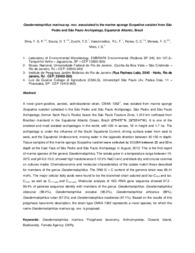Geodermatophilus marinus sp. npv. associated to the marine sponge Scopalina ruetzleri from São Pedro and São Paulo Archipelago, Equatorial Atlantic, Brazil.
Geodermatophilus marinus sp. npv. associated to the marine sponge Scopalina ruetzleri from São Pedro and São Paulo Archipelago, Equatorial Atlantic, Brazil.
Author(s): SILVA, F. S. P. da; SOUZA, D. T.; ZUCCHI, T. D.; VASCONCELLOS, R. L. F.; PANSA, C. C.; MORAES, F. C.; MELO, I. S. de
Summary: A novel gram-positive, aerobic, actinobacterial strain, CMAA 1362T, was isolated from marine sponge Scopalina ruetzleri collected in the São Pedro and São Paulo Archipelago. São Pedro and São Paulo Archipelago (former Saint Paul`s Rocks) liaison the São Paulo Fracture Zone, 1,010 km northeast from Brazilian mainland in the Equatorial Atlantic Ocean, Brazil (0°54’57”N; 29°20\41\"W). It is one of the smallest and most isolated archipelagos in the world, with 420 m across, 18 m height and 1.7 ha. The archipelago is under the influence of the South Equatorial Current, driving surface water from east to west, and the Equatorial Undercurrent, moving water in the opposite direction between 40-150 m depth. Tissue samples of the marine sponge Scopalina ruetzleri were collected by SCUBA between 20 and 30 m depth at the East Face of São Pedro and São Paulo Archipelago in August, 2013. This is the first report of marine species of the genera Geodermatophilus. The isolate grew in a temperature range between 15-30°C and pH 6.0-10.0, showed high halotolerance 5-12.5% NaCl (w/v) and black-dry and circular colonies on cultures media. Chemotaxonomic and molecular characteristics of the isolate match those described for members of the genus Geodermatophilus. The DNA G + C content of the genome strain was 69.41 mol%. The major cellular fatty acids were found to be the branched-chain satured acid iso-C16:0 and iso-C15:0, as well as C17:1?8c and C18:1?9c. Molecular analysis of 16S rRNA gene sequence showed 97.2 - 98.4% of pairwise sequence identity with members of the genus Geodermatophilus: Geodermatophilus obscurus (98.4%), Geodermatophilus siccatus (98.3%), Geodermatophilus africanus (98%), Geodermatophilus ruber (97.3%) and Geodermatophilus tzadiensis (97.1%). Based on the results of this polyphasic taxonomic description, the strain type CMAA 1362 represents a novel species, for which the name Geodermatophilus marinus sp. nov. is proposed.
Publication year: 2015
Types of publication: Abstract in annals or event proceedings
Unit: Embrapa Environment
Observation
Some of Embrapa's publications are published as ePub files. To read them, use or download one of the following free software options to your computer or mobile device. Android: Google Play Books; IOS: iBooks; Windows and Linux: Calibre.
Access other publications
Access the Agricultural Research Database (BDPA) to consult Embrapa's full library collection and records.
Visit Embrapa Bookstore to purchase books and other publications sold by Embrapa.

